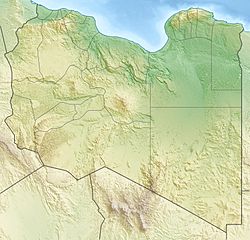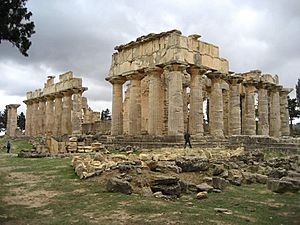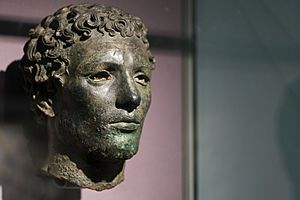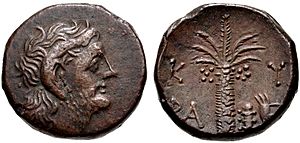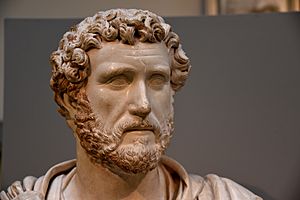Cyrene, Libya facts for kids
|
Κυρήνη
|
|
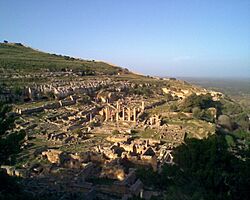
Sanctuary of Apollo at Cyrene
|
|
| Alternative name | Kyrene |
|---|---|
| Location | Shahhat, Jabal al Akhdar, Cyrenaica, Libya |
| Region | Jebel Akhdar |
| Coordinates | 32°49′30″N 21°51′29″E / 32.82500°N 21.85806°E |
| Type | Settlement |
| History | |
| Builder | Colonists from Thera led by Battus I |
| Founded | 631 BC |
| Abandoned | 7th century AD |
| Periods | Archaic Greece to Umayyad Caliphate |
| Site notes | |
| Official name: Archaeological Site of Cyrene | |
| Type: | Cultural |
| Criteria: | ii, iii, vi |
| Designated: | 1982 (6th session) |
| Reference #: | 190 |
| Region: | Arab States |
Cyrene (pronounced Ky-REE-nee) was an important ancient Greek city. It later became a Roman city. You can find its ruins near the modern town of Shahhat in northeastern Libya, in North Africa. Cyrene was one of five major cities in its region, known as the Pentapolis. This group of cities gave the whole area its name, Cyrenaica.
Cyrene is located on a high ridge of the Jebel Akhdar mountains. Its ancient ruins cover a large area. You can see impressive temples, public buildings called stoas, theaters, bathhouses, and even churches. The city is also surrounded by a huge ancient cemetery called the Necropolis of Cyrene. Since 1982, Cyrene has been recognized as a UNESCO World Heritage Site. The city's port, Apollonia, was about 16 kilometers (10 miles) north, by the sea.
The Greeks believed the city was named after the god Apollo and a legendary princess named Cyrene. However, it was likely settled by people from Thera (a Greek island) around 631 BC. Early on, kings from the Battiad family ruled Cyrene. They became very rich by exporting horses and a special medicinal plant called silphium. By the 400s BC, Cyrene controlled other cities in Cyrenaica. It also became famous for a school of philosophy called the Cyrenaics. This school was founded by Aristippus, a student of the famous philosopher Socrates.
Later, Cyrene was sometimes part of Ptolemaic Egypt and sometimes an independent kingdom. It was also an important center for Jewish people. In 96 BC, it became part of the Roman Republic. In 115 AD, the city was badly damaged during a Jewish revolt. It was slowly rebuilt over the next century. Earthquakes in 262 and 365 AD also caused a lot of damage. People continued to live there until the Arab conquest in 642 AD. After that, the site was abandoned until 1913, when Italian soldiers set up a base there. Archaeologists have been studying the site ever since.
Contents
What's in a Name?
The name Cyrene comes from the Greek word Kȳrḗnē. The Greeks themselves had a story about how the city got its name. They said it was named after a princess from Thessaly (a region in Greece) named Cyrene. She supposedly founded the city with help from the sun god Apollo.
Some modern experts think the city might have been named after a local spring called Cyra. This spring was considered sacred to Apollo. However, the legend of Princess Cyrene seems older than any mention of the spring. So, it's possible the early Greek settlers just used an existing local name that sounded similar.
A Look Back in Time
People have lived in the Cyrenaica region for a very long time, even since the Stone Age. There's some evidence that people lived in caves below Cyrene's main hill before the Greeks arrived. It's possible that ancient people from Minoan and Mycenaean civilizations visited Cyrene during the Bronze Age. This area was an easy sea route from the Aegean Sea to Egypt. However, the only proof found so far are a small Minoan altar and a seal, which could have arrived later.
How Cyrene Began
A Greek myth, first written down by the poet Pindar, says that the god Apollo fell in love with a huntress named Cyrene. He brought her to Libya, where she had a son named Aristaeus.
Greek historical stories, like those by Herodotus, say that Greek settlers founded Cyrene in 631 BC. These settlers were from the island of Thera. They were led by Battus I, and they were encouraged by the Oracle of Delphi. Some stories say they left Thera because of a famine, others because of a civil war. Most say they first settled on an island before moving to Cyrene. We don't know for sure how accurate these stories are.
Archaeological finds, especially pottery, confirm that Greeks started settling here in the mid-600s BC. This early pottery came from Thera, Sparta, Samos, and Rhodes. The city quickly grew from its first settlement area. Important religious sites, like the sanctuaries of Apollo, Demeter, and Zeus, were built in the 600s or 500s BC. Other cities in Cyrenaica, like Apollonia, were also settled around the same time.
Early Cyrene: Kings and Conflicts
After it was founded, Cyrene was ruled by a line of kings descended from Battus I. During the 500s BC, Cyrene became the most powerful city in the region. Battus II encouraged more Greeks to settle in the city. This led to fights with the local Libyan people. Around 570 BC, the Libyan king Adicran asked Egypt for help. The Egyptian pharaoh Apries attacked Cyrene, but he was soundly defeated.

According to Herodotus, a conflict with King Arcesilaus II (around 560-550 BC) caused his brothers to leave and found the city of Barca to the west. Arcesilaus was defeated by the people of Barca and the Libyans. He was later killed by his brother. His young son Battus III became king. Cyrene continued to have internal problems. These were solved when a lawmaker named Demonax from Mantinea reformed the city's laws. These changes likely limited the king's power to religious matters. They gave more political power to the people of Cyrene.
King Arcesilaus III (around 530-515 BC) tried to undo Demonax's changes and was forced to leave. He returned with an army and took back control. But he was later forced out again and killed in Barca. His mother, Pheretime, asked the Persian governor of Egypt for help. The Persians then attacked and looted Barca in 515 BC. It's possible that Cyrene was also conquered by the Persians at this time.
Classical Period: Prosperity and Philosophy
In the 400s BC, Cyrene's control over the other Greek cities in Cyrenaica grew stronger. The city was very wealthy. Many important buildings were constructed during this time. These include the Temple of Apollo, the Temple of Zeus, and the Temple of Demeter.
Cyrene's main export was the medicinal plant silphium. This plant was so important that it was shown on most Cyrenian coins. However, it was harvested so much that it became extinct by the end of the 1st century BC. Cyrene also earned money from raising horses and from trade between Egypt, Greece, and Carthage. It was a stopping point for Greeks traveling to visit the oracle of Ammon at Siwah.
In 454 BC, Cyrene offered safety to the remaining Athenian soldiers who had been defeated by the Persians in Egypt. Later, during the Peloponnesian War, Cyrene helped Spartan forces by providing ships and guides.
Towards the end of the 400s BC, a man named Ariston took control of Cyrene. He had many leading citizens killed or exiled. He may have tried to create a radical democracy, similar to Athens. Later, a group of 3,000 Messenians arrived and joined forces with the exiles. After a battle, the Cyrenean exiles and Ariston's followers made peace.
During the 300s BC, Cyrene had disputes with Carthage over trade routes. Cyrene also built a treasury at Delphi in Greece. When Alexander the Great conquered Egypt in 331 BC, Cyrene sent a message of friendship. They did not come under Macedonian control. An inscription shows that during a famine in the late 320s BC, Cyrene sent a huge amount of grain to other Greek cities and the Macedonian royal family.
Hellenistic Period: Under Egyptian Rule
In 324 BC, a Spartan soldier named Thibron invaded Cyrenaica. He captured Cyrene's port and forced the city to accept his rule. However, Cyrene later allied with the Libyans and Carthaginians. Thibron returned and defeated them.
A democratic revolution then happened in Cyrene. The exiled aristocrats asked Ptolemy I Soter (the ruler of Egypt) for help. Ptolemy sent his general Ophellas to take over the city. He set up a new government that gave him a permanent role in the city's administration. Cyrene became part of the Ptolemaic realm (Egypt) in 321 BC. Cyrenean rebels tried to remove the Ptolemaic soldiers in 313 BC, but Ptolemy sent more troops to stop the revolt.
Cyrene rebelled against Ptolemy again around 305 BC. Control was re-established in 300 BC by Ptolemy's step-son Magas. After Ptolemy's death in 282 BC, Magas crowned himself king of Cyrene. He even helped the Seleucid king Antiochus I in an invasion of Egypt. After Magas died, his daughter Berenice married Ptolemy III in 246 BC. This brought Cyrene back under Ptolemaic control. During this time, the cities of Cyrenaica formed a group called the Pentapolis, which even minted its own coins.
Cyrene was given to Ptolemy VIII as a separate kingdom in 163 BC. He made a will saying that if he died without heirs, Cyrene would go to the Roman Republic. He later regained control of Egypt. His illegitimate son, Ptolemy Apion, was given Cyrene as a separate kingdom around 105-101 BC. Apion also made a will giving the territory to Rome. So, when he died without heirs in 96 BC, Cyrene became Roman territory.
Cyrene became an important Jewish center during this period. The book of 2 Maccabees in the Bible is said to be a shorter version of a work by a Jewish writer named Jason of Cyrene, who lived around 100 BC.
Roman Period: Rebuilding and Decline
After 96 BC, the Romans didn't immediately take full control of Cyrene. A tyrant named Nicocrates ruled for a while, but he was overthrown. In 74 BC, the Romans finally sent a governor. Cyrenaica became part of the Roman province of Crete and Cyrenaica. Cyrene remained the main city in Cyrenaica. It had a very prosperous period, and many buildings were constructed in the 1st century AD.
Because of its large Jewish population, Cyrene was an early center for Christianity. A man from Cyrene named Simon helped Jesus carry his cross. The Acts of the Apostles mentions that Jews from Cyrene heard the disciples speaking in their own language on the day of Pentecost. It also says that Christians from Cyrene were among the early believers.
In 115 AD, a huge Jewish revolt broke out in Cyrenaica and other regions. Cyrene was attacked and almost all its buildings were destroyed. Historical sources claim that many people were killed. The Roman emperor Hadrian later had to establish new settlements to repopulate the area. Restoration work on Cyrene took a long time, lasting until the reign of Emperor Commodus. By the late 100s AD, Cyrene was prosperous again. Several grand homes, like the House of Jason Magnus, were built during this time.
In the mid-200s AD, Cyrene's economy started to decline. An earthquake in 262 AD destroyed much of the city. After this disaster, the city was attacked by Libyan nomads. Emperor Claudius Gothicus restored Cyrene, renaming it Claudiopolis. Many buildings were rebuilt, but a new defensive wall only protected half of the city.
Byzantine Period: Last Days
Another major earthquake hit Cyrene on July 21, 365 AD. Skeletons crushed by falling stones have been found. A historian at the time described Cyrene as "an ancient but deserted city." However, the damage might have been exaggerated. Archaeology shows that while most buildings were damaged, many were rebuilt. Even some temples were rebuilt, though they were later closed by Christian laws in 395 AD.
A wealthy man named Synesius, who later became a bishop, grew up in Cyrene after the earthquake. His letters show that Cyrene was still an important center. Churches were built in the 400s or 500s AD. There was still a bishop of Cyrene in the early 600s AD. The city fell to the Arab conquest in 643 AD. After that, it was abandoned.
Modern History: Rediscovery and Preservation
The site of Cyrene was completely abandoned for many centuries. In the early 1800s, explorers Frederick and Richard Beechey visited and made the first maps of the site. Later, parts of a tomb were looted for the Louvre museum in France. The first scientific excavations began in 1860-1861. Their findings, including the Apollo of Cyrene statue, mostly went to the British Museum.
More scientific excavations started in 1910 but were stopped by the Italian invasion of Libya in 1911. The Italian colonial government set up a military base at the site in 1913. While building the base, Italian soldiers found the "Venus of Cyrene", a headless marble statue of the goddess Venus. This discovery led them to limit their base to the Acropolis. The statue was taken to Rome and stayed there until 2008, when it was returned to Libya. The modern village of Shahat grew up around the Italian presence.
The Italians carried out large-scale excavations at Cyrene. These were often connected to their government's propaganda. Italian archaeologists were expelled in 1943 when the Allies captured Cyrenaica. Later, Richard Goodchild, who managed antiquities, moved the village of Shahat away from the ancient site. He also gave control of excavations back to the Italians. Much of the site has been excavated and several buildings have been restored.
In 1982, Cyrene was declared a UNESCO World Heritage Site. Since 2006, various organizations have worked to preserve the ancient site. This includes conservation work and training local workers. In 2017, UNESCO added Cyrene to its List of World Heritage in Danger due to threats to the site.
Exploring the Ancient City
Cyrene is now an archaeological site north of the village of Shahhat. It sits on a ridge of the Jabal Akhdar mountains, about 600 meters (2,000 feet) above sea level. The Acropolis, at the western end of the ridge, was where the Greeks first settled.
From the Acropolis, a road called the "Street of Battus" runs southeast for about 1 kilometer (0.6 miles). Along this road, you can see the Agora (public square), the House of Jason Magnus, other grand homes, the Stoa of Hermes and Heracles, the Caesareum, two theaters, and a sacred area.
Below the Acropolis to the north, the Springs of Apollo and Cyra flow from the cliff. This area contains the Greek Theatre, the Sanctuary of Apollo, and the Baths of Trajan. Another road, "Valley Street," runs southeast from the sanctuary, parallel to the "Street of Battus." It passes the Baths of Paris and the Market Theatre.
To the northeast, inside the city walls, is the largely unexcavated northeastern quarter. This area contains the Temple of Zeus, the hippodrome (a track for horse races), and the East Church. Outside the city walls to the south is the Sanctuary of Demeter and Persephone. The necropolis of Cyrene (cemetery) covers about 20 square kilometers (7.7 square miles) to the south and north of the city.
Archaeological finds are kept and displayed in a temporary museum at the site. In 2005, Italian archaeologists found 76 intact Roman statues from the 2nd century AD. They were hidden for so long because an earthquake in 375 AD caused a wall to fall, burying them.
Sanctuary of Apollo
One of the most important features of Cyrene is the temple of Apollo. It was first built as early as the 600s BC. Other ancient structures include a temple to Demeter. There is a large necropolis (cemetery) about 10 kilometers (6 miles) between Cyrene and its ancient port of Apollonia.
Temple of Zeus
The Temple of Zeus was the largest ancient Greek temple in Cyrene. It was one of the biggest Greek temples ever built. The original temple was constructed around 500-480 BC. It was huge, similar in size to the Temple of Zeus at Olympia and the Parthenon in Athens.
This temple was destroyed in 115 AD during the Jewish attack on the city. It was partly rebuilt around 172-175 AD. Between 185 and 192 AD, a giant statue of Zeus, similar to the famous Statue of Zeus at Olympia, was placed inside. The temple was destroyed again in 365 AD by an earthquake. It was later burned by Christians.
Sanctuary of Demeter and Persephone
The sanctuary dedicated to Demeter and Persephone is located south of the city walls. It includes a temple and a theater complex. The sanctuary is spread out over three levels. Archaeological remains show that it was used from the late 600s BC to the mid-200s AD. Many offerings were found here, such as pottery, lamps, coins, sculptures, jewelry, and small statues. The pottery found helps us understand when the sanctuary was founded and what kind of religious activities took place there.
Necropolis (Cemetery)
The necropolis is a vast cemetery with graves, tombs carved into rock, temple-like tombs, and sarcophagi. It dates from the 500s BC to the 400s AD. It covers about 20 square kilometers (7.7 square miles) to the south and north of the city. This makes it one of the largest known Greek cemeteries. The southern part has been affected by the growing town of Shahat. The northern part is better preserved. Many Roman-era tombs have special spots for portrait busts of the people who died. A common find is statues of the "Goddess of Death," a female bust often without a face, shown as if she is revealing herself.
Water System
In October 2023, a flood uncovered an ancient water canal. It might date back to the Roman era, showing how advanced their water systems were.
Ideas and Thinkers
Cyrene was a place of great intellectual activity, home to famous philosophers and mathematicians. The School of Cyrene, known as the Cyrenaics, was founded here by Aristippus. He was a student of Socrates. This school focused on the idea that pleasure is the highest good.
Famous People from Cyrene
- Arete of Cyrene, a female philosopher.
- Aristippus (around 435 – 356 BC), philosopher and founder of the Cyrenaic School.
- Callimachus (310/305 – 240 BC), a famous poet, critic, and scholar at the Library of Alexandria.
- Eratosthenes (276 – 194 BC), a mathematician, geographer, and astronomer. He was a librarian at the Library of Alexandria. He was the first to calculate the circumference of the Earth.
- Lacydes (3rd century BC), a philosopher.
- Simon of Cyrene, the man who helped carry the cross of Jesus.
- Synesius (around 373 – 414 AD), an author and bishop.
- Theodorus (around 5th century BC), a mathematician.
Images for kids
See also
 In Spanish: Cirene para niños
In Spanish: Cirene para niños


